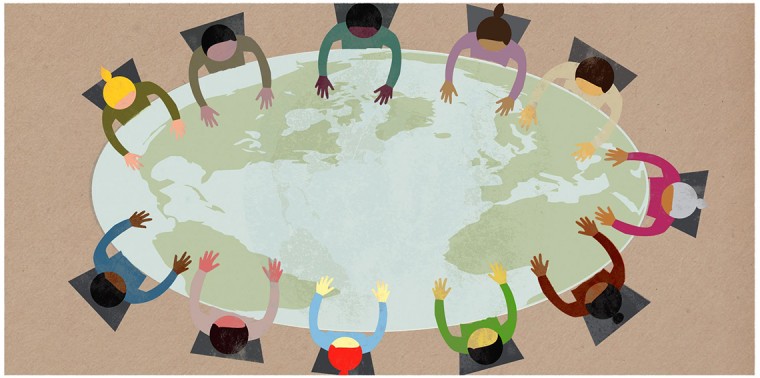While it’s valuable to implement philanthropic initiatives into your corporate culture, building social purpose into every aspect of your business is how real impact is made.
Social purpose: it’s a trend and a term on many lips these days–but some local businesses are struggling to catch on.
“Social purpose is taking corporate social responsibility (CSR) to a completely new level,” says Mary Ellen Schaafsma, director of social innovation and research with United Way of the Lower Mainland, which recently hosted a workshop on the topic. Where CSR advocates philanthropy as a means of giving back, boosting corporate image and bolstering profits, this new iteration places social good at the very core of a business.
“A company’s reason for being can no longer be its product and services—rather it must leverage its products and services as a mechanism to create social good. This in turn creates a model of sustainability for the business, because society sees the business contributing to the community,” says Schaafsma. She adds: “Traditional CSR has done a lot of good; it’s just not enough any more.”
Why? Partly a shift in attitudes and expectations among customers and employees, especially millennials. “They’re not just looking for a job and paycheque—they’re looking for purpose in their work,” says Schaafsma. “If companies embrace true social purpose, they will find it easier to find top-notch employees and retain customers.”
Some local companies are well on their way. Schaafsma points to local social leaders such as Vancity Credit Union and Mountain Equipment Co-op, which embody their social purposes of community development and outdoor activity, respectively, in all pursuits. Other businesses aren’t sure where to begin, but are “thirsty” for guidance, says Schaafsma.
Enter United Way, a social leader in its own right—and one uniquely positioned to play matchmaker, thanks to its existing relationships in the corporate world, government, social agencies and unions.
“This isn’t just about businesses on their own adopting social purpose,” says Schaafsma. “This is about coming to the table with all the other players to tackle the root causes of social issues, and creating long-term solutions.”
Social Purpose in Play
Coro Strandberg, president, Strandberg Consulting
Strandberg has worked in corporate social responsibility for more than 20 years—including a stint on the Vancity Credit Union board. To help a company identify their social purpose, she first suggests uncovering a company’s genesis story: “Most businesses were created to meet a need in society,” say Strandberg. Can you connect that to a modern-day social issue? Alternatively, research community issues in your area, or investigate whether current customers are using your product in a way that creates social value. But whatever the social purpose, you must deeply embed it into your operation. “By doing this, you attract more customers and increase customer loyalty. Customers become brand ambassadors,” she says. “It’s a virtuous cycle of growth.”
James Belsheim, president, Neptune Bulk Terminals
To identify its social purpose, North Vancouver’s Neptune Terminals looks local, and long-term. “We take time to understand the community, looking at where the gaps are and how we can make the biggest difference,” says Belsheim. The company works closely with United Way of the Lower Mainland, which helped Neptune hone in on at-risk youth—particularly those with learning disabilities—and seniors’ well-being in North Vancouver. While these issues might not immediately impact the company’s bottom line, that’s not really the point, says Belsheim. “For us, it’s about building community trust long-term,” he says. “We also want people to be proud of working at Neptune. Our efforts in the community give them that pride.”
David Labistour, CEO, Mountain Equipment Co-op
Promoting outdoor activity and healthy living wasn’t much of a leap for a Canadian outdoor-recreation gear company. But Mountain Equipment Co-op (MEC) has integrated this social purpose into its business to such a degree that it develops its products and operates its business through the lens of how best to help and encourage people to get off the couch and out the door. For Labistour, it’s about understanding customers, and people in general. “The more value we can provide to the people in our communities, the greater our brand trust and social license to operate will be. This includes the consideration for those who make our products and the environments in which they are made.”
The Evolution: Philanthropy to Social Purpose
STAGE 1. PHILANTHROPY
WHAT: A corporation shows goodwill by giving back to community.
EXAMPLE: During this holiday season, a company collects items and comes together as a group to put together Christmas hampers and tells the story through paid advertising.
BUSINESS VALUE: Goodwill.
STAGE 2. STRATEGIC
WHAT: A corporation understands the value of supporting the community and becomes
strategic with its actions.
EXAMPLE: A company decides to give back by establishing a community grant, and the
story is spread through the news media.
BUSINESS VALUE: Reputation.
STAGE 3. INTEGRATED
WHAT: A corporation realizes the competitive advantage gained through philanthropy, and designs products and services to be socially beneficial.
EXAMPLE: Social hiring (hire local, support people with barriers to employment). The customer shares the brand’s story.
BUSINESS VALUE: Profitability.
STAGE 4. SOCIAL PURPOSE
WHAT: A corporation bases its reputation on social good, and the whole enterprise is creating a social movement.
EXAMPLE: The business purpose supports a higher level of social purpose. Everything it does tells the story, and relates back to the movement.
BUSINESS VALUE: Sustainability.
This article was taken from here.

